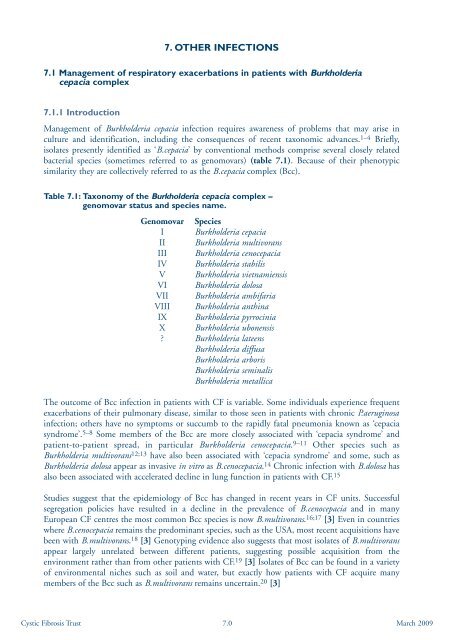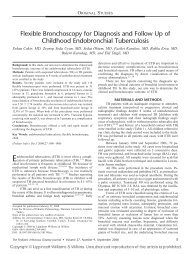Report of the UK Cystic Fibrosis Trust Antibiotic Working Group
Report of the UK Cystic Fibrosis Trust Antibiotic Working Group
Report of the UK Cystic Fibrosis Trust Antibiotic Working Group
You also want an ePaper? Increase the reach of your titles
YUMPU automatically turns print PDFs into web optimized ePapers that Google loves.
7. OTHER INFECTIONS7.1 Management <strong>of</strong> respiratory exacerbations in patients with Burkholderiacepacia complex7.1.1 IntroductionManagement <strong>of</strong> Burkholderia cepacia infection requires awareness <strong>of</strong> problems that may arise inculture and identification, including <strong>the</strong> consequences <strong>of</strong> recent taxonomic advances. 1–4 Briefly,isolates presently identified as ‘B.cepacia’ by conventional methods comprise several closely relatedbacterial species (sometimes referred to as genomovars) (table 7.1). Because <strong>of</strong> <strong>the</strong>ir phenotypicsimilarity <strong>the</strong>y are collectively referred to as <strong>the</strong> B.cepacia complex (Bcc).Table 7.1: Taxonomy <strong>of</strong> <strong>the</strong> Burkholderia cepacia complex –genomovar status and species name.Genomovar SpeciesI Burkholderia cepaciaII Burkholderia multivoransIII Burkholderia cenocepaciaIV Burkholderia stabilisV Burkholderia vietnamiensisVI Burkholderia dolosaVII Burkholderia ambifariaVIII Burkholderia anthinaIX Burkholderia pyrrociniaX Burkholderia ubonensis? Burkholderia lateensBurkholderia diffusaBurkholderia arborisBurkholderia seminalisBurkholderia metallicaThe outcome <strong>of</strong> Bcc infection in patients with CF is variable. Some individuals experience frequentexacerbations <strong>of</strong> <strong>the</strong>ir pulmonary disease, similar to those seen in patients with chronic P.aeruginosainfection; o<strong>the</strong>rs have no symptoms or succumb to <strong>the</strong> rapidly fatal pneumonia known as ‘cepaciasyndrome’. 5–8 Some members <strong>of</strong> <strong>the</strong> Bcc are more closely associated with ‘cepacia syndrome’ andpatient-to-patient spread, in particular Burkholderia cenocepacia. 9–11 O<strong>the</strong>r species such asBurkholderia multivorans 12;13 have also been associated with ‘cepacia syndrome’ and some, such asBurkholderia dolosa appear as invasive in vitro as B.cenocepacia. 14 Chronic infection with B.dolosa hasalso been associated with accelerated decline in lung function in patients with CF. 15Studies suggest that <strong>the</strong> epidemiology <strong>of</strong> Bcc has changed in recent years in CF units. Successfulsegregation policies have resulted in a decline in <strong>the</strong> prevalence <strong>of</strong> B.cenocepacia and in manyEuropean CF centres <strong>the</strong> most common Bcc species is now B.multivorans. 16;17 [3] Even in countrieswhere B.cenocepacia remains <strong>the</strong> predominant species, such as <strong>the</strong> USA, most recent acquisitions havebeen with B.multivorans. 18 [3] Genotyping evidence also suggests that most isolates <strong>of</strong> B.multivoransappear largely unrelated between different patients, suggesting possible acquisition from <strong>the</strong>environment ra<strong>the</strong>r than from o<strong>the</strong>r patients with CF. 19 [3] Isolates <strong>of</strong> Bcc can be found in a variety<strong>of</strong> environmental niches such as soil and water, but exactly how patients with CF acquire manymembers <strong>of</strong> <strong>the</strong> Bcc such as B.multivorans remains uncertain. 20 [3]<strong>Cystic</strong> <strong>Fibrosis</strong> <strong>Trust</strong> 7.0March 2009






